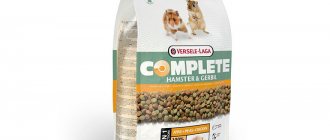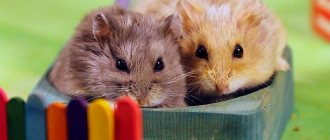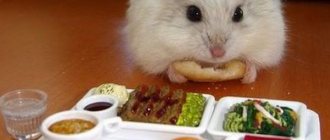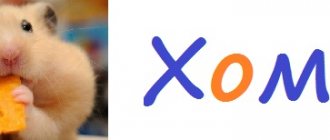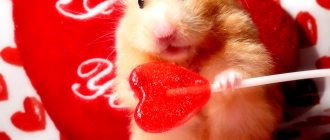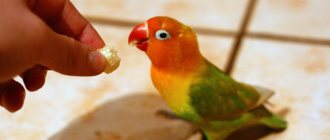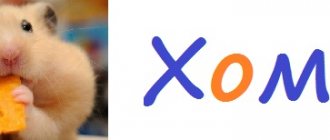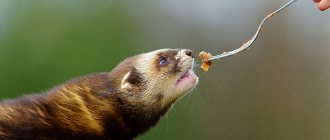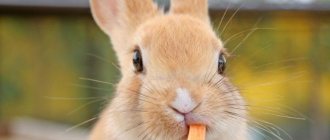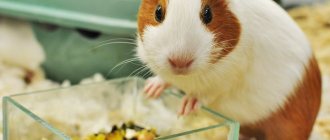Caring for a Djungarian hamster is not at all difficult. A well-equipped, comfortable cage and timely, appropriate food are the main principles of caring for a pet.
If you do not follow certain nutritional rules, the hamster may get sick and will live with the owner for a short time. Djungarians eat literally everything that is not offered.
However, not all products are recommended for them. You should include only food that is healthy for your animal in your diet. What can be given to a small animal and what cannot be given? How to create the ideal menu for a hamster? Let's consider the basic requirements for nutrition and diet.
The Djungarian hamster may not immediately evaluate the brand of the mixture; sometimes, to find the optimal option, you have to go through several brands. Usually one package of store-bought mixture lasts for one and a half or two months.
Some owners prepare grain mixtures themselves. In this case, they dilute the above composition with buckwheat, beans, lentils, and barley. It is not forbidden to add melon, pumpkin or sunflower seeds to such food.
Hamsters love nuts; you can add nuts, cashews, chickpeas, sesame seeds, and hazelnuts. Do not forget about the quality of such a mixture; all products must be fresh.
What is possible?
You can diversify your hamster's diet at home with an extensive list of products. Djungarians benefit from greens; in the summer, you can pamper your pet with clover, plantain leaves, dill, and parsley. Extensive list of vegetables and fruits.
The vegetable diet of the Djungarian hamster includes:
- Bell pepper.
- Broccoli.
- Fresh corn, beans and peas.
- Carrot.
- Cucumbers and fresh tomatoes.
- Cauliflower.
- Pumpkin.
If you include fruits in your diet, hamsters can eat bananas, grapes, apricots, apples and plums.
It is not forbidden to feed the Djungarian hamster at home with cherries, sweet cherries, rose hips, strawberries, and gooseberries. Pear should be pampered in rare cases, it “weakens”. It is worth giving hamsters protein food twice a week. Rodents eat boiled chicken meat without salt and seasonings, and peeled shrimp. You can find earthworms in pet stores. Chicken and quail eggs can be eaten in small quantities and in rare cases. The same applies to low-fat kefir.
Djungarian hamsters enjoy gnawing tree branches. Fresh branches of birch, cherry, maple, pear, oak, and apple are suitable for them.
It is important to take precautions when feeding. You need to remove seeds from fruits and berries, as jungarians can eat everything and can choke. All uneaten remains should be removed; spoiled pieces can cause poisoning.
Can hamsters eat tangerines?
Tangerines also belong to the group of citrus fruits, so the answer to the question of whether it is acceptable to give tangerines to hamsters is clearly negative. The reasons for this categorical ban are similar to those for which oranges were removed from the diet of rodents.
Their exclusion from the menu of Djungarian, Syrian and other hamsters applies to all types of citrus fruits, so owners looking for information about whether hamsters can eat lemon will also be faced with disappointing information - sour slices are very harmful to rodents.
Recommended Products
In the wild, hamsters eat mainly grain crops; this nuance can be taken into account when composing the diet of the dzhungarik.
In addition to grain crops, in the wild hamsters can also eat animal food, sometimes turning into a predator, eating carrion or killing smaller animals. At home, you should take this factor into account when choosing food.
Special dry food
Diet at home must include special grain feed.
There are a huge variety of them on our market, so you can offer the dzhungarik a choice and follow his preferences. In addition to their composition, they differ strikingly in their quality, which is also worth paying attention to. The case when a home protests and flatly refuses a certain brand is far from uncommon. Also, you should not feed your Djungarian hamster with grain mixtures intended for other animals.
Protein food
A couple of times a week you should feed the jungarik with protein foods, such as cottage cheese or a piece of boiled chicken; a boiled chicken or quail egg, or low-fat boiled fish are perfect. All of the above products must be prepared without spices and seasonings that are harmful to the small body.
Let's look at the list of products that you can still feed the homa:
| Cereals: | Nuts: | Seeds: | Greenery: |
|
|
|
|
Before feeding homa with parsley, dill and other herbs, rinse and dry it thoroughly. Thanks to this simple procedure, moisture that may contain harmful substances will disappear. Remember that parsley has a laxative effect and should not be given if the homa is pregnant.
Is it possible to feed hedgehogs milk?
These babies do not have the enzyme in their body that breaks down lactose. If you offer a hedgehog cow's milk, he will, of course, drink it, but will soon begin to suffer from indigestion. Sometimes hedgehogs experience food poisoning and diarrhea.
Moreover, cow's milk contains antibodies that can simply destroy the body of a small animal. So says Moscow Zoo zoologist Alexey Turovsky. However, the specialist notes that this does not apply to goat or dog milk.
The zoologist explains the killing effect of cow's milk on hedgehogs by the fact that in natural habitats such food is completely excluded for them. “In order not to make the animal worse, you should not feed it at all,” Turovsky says about hedgehogs. The zoologist claims that any wild animal, if it is healthy, is able to feed itself.
“The generally accepted opinion that hedgehogs are hungry and want to eat is a misconception,” notes the zoologist. In summer, hedgehogs really have no problems with food. However, in early spring, these animals still need food.
In this case, hedgehogs can be fed with available food: cat or dog food, raw eggs, boiled sausage, tomatoes, lettuce, apples, carrots, pears. If possible, the hedgehog should be given fresh, cool water in a bowl after feeding.
Probably, each of us at least once in our lives, either in the village, or on TV, saw a cute, fluffy, prickly baby hedgehog drinking milk from a saucer. This composition cannot help but touch you.
However, if you decide to give your children joy and have such a cute pet at home, then you should know everything about the diet of these animals, including, for example, whether hedgehogs can drink milk.
Scientific information about hedgehogs breaks all stereotypes about these animals. So, from an early age we drew hedgehogs with an apple, pear or mushroom on their needle-like back. Therefore, it is surprising to learn that hedgehogs do not actually eat mushrooms and apples; these animals are carnivores by nature and prefer to eat meat and insects.
Living in the wild, the hedgehog happily eats snails, caterpillars, various beetles, and earthworms.
Therefore, when a hedgehog moves into the house, the owners need to make sure that its usual diet changes only on a minor scale. If it is not possible to supply the hedgehog with cockroaches, crickets or (what a nightmare) mice, then the hedgehog should be treated to fresh fish, boiled liver, raw and boiled meat. From this food, which is familiar to people, a hedgehog is also able to take the useful microelements and substances necessary for its existence.
Also, hedgehogs will not turn their nose up at a carrot or an apple. But the most favorite treat for a hedgehog is milk. On the Internet, among the tips for feeding a hedgehog at home, it is recommended to treat the prickly one with bread soaked in milk.
But can hedgehogs actually drink milk or should they be fed milk-soaked bread?
Most zoologists answer this question that hedgehogs can drink milk, but only goat or sheep milk. Cow's milk should not be given to hedgehogs. The thing is that cow's milk contains antibodies that kill hedgehogs. In addition, hedgehogs are deprived of the ability to break down lactose; they do not have a special enzyme for this. Drinking cow's milk can not only cause an upset stomach in a hedgehog, but also lead to the death of the animal.
Even though hedgehogs, like many other animals, are milk drinkers for its taste and smell, they should not be given milk because in the wild milk is not a component of their diet.
Thus, so that your pet does not get sick and lives happily ever after, try to feed it food familiar to its body from meat and insects and indulge it less in sweets, which include cow’s milk.
Feed with caution
Dwarf hamsters, which include Djungarian hamsters, are prone to diabetes, so fruits and berries should be fed in moderation and carefully.
If you want to diversify your homa's diet with fresh foods, then instead of fruits, you can focus on vegetables.
Below is a list of vegetables, fruits and berries that, in moderate quantities, will not harm the health of the dwarf, but on the contrary, will replenish the supply of vitamins and nutrients.
Fruits and berries:
- Apple.
- Banana.
- Peach.
- Cherries.
- Plum.
- Blueberry.
- Rose hip.
- Strawberry.
- Grushka.
- Grape.
Fruits can be offered to Djungarian hamsters after they reach two months of age.
Make sure that no half-eaten pieces are left in the cages; they spoil quickly and can ultimately lead to poisoning of the rodent. Some varieties of pear have a laxative effect, so it should be introduced gradually and in small quantities.
Vegetables:
- Zucchini.
- Chinese cabbage.
- Eggplant.
- Cucumber.
- Radish.
- Radish.
- Cauliflower.
- Pumpkin.
- Tomato.
- Beet.
- Green beans.
- Fresh corn.
- Carrot.
Tomatoes can be fed to homa if they are grown in your garden, since the varieties sold on the market often contain a lot of pesticides.
A similar rule is fully applicable to cucumbers. Beets will not harm your pet, but they actually do not contain any beneficial substances. But carrots must be included in the homa diet.
Dried fruits:
- Banana chips.
- Dried apples.
- Dried pears.
- Dried apricots.
- Raisin.
Fruits and vegetables grown yourself or purchased from safe places will be a big plus.
Poisoning people with pesticides is far from uncommon, let alone such miniature creatures, for which such a dose would be fatal. As for dried fruits, due to their high sugar content, they should be given in small quantities.
Do not allow dzhungarik to eat citrus fruits, they are harmful for such a small organism, this rule also applies to sour berries, such as barberry or sea buckthorn. Tropical fruits should be avoided in the homa diet, with the exception of bananas or banana chips.
What berries can you give?
Juicy seasonal berries should undoubtedly be present in a hamster's diet, because they are a rich source of a wide range of vitamins and minerals. Eating them helps keep the immune system in order; you are allowed to treat:
- wild forest rowan;
- blackberries;
- strawberries;
- blueberries;
- cranberries;
- strawberries;
- white and red currants.
In very limited quantities, the hamster is occasionally given the following berries:
- lingonberries;
- blueberries;
- chokeberry;
- ripe unsweetened grapes (seedless);
- pitted cherries and cherries;
- raspberries;
- gooseberry;
- black currants.
List of prohibited products
You should not give white cabbage to dzungarians to eat, it causes increased gas formation and is difficult to digest. There have been cases when it caused the death of a poor rodent. Limit khoma from potatoes, they are too hard to digest and can contain huge amounts of pesticides, plus they have too much starch.
Remember that any branches of fruit trees collected in the city can seriously harm the dzhungarika, having a detrimental effect on health. Given our ecology, this fact does not even require explanation.
Good quality twigs can be purchased at pet stores, but be sure to heat them before giving them to your rodent.
Under no circumstances give Djungarian hamsters food from your table.
Fried, fatty and floury foods are very harmful to his health. Below, in the list, we will take a closer look at the foods that should not be given to Djungarian hamsters, these are:
- Salt.
- Pepper.
- Sugar.
- Honey.
- Onion.
- Watermelon.
- Sour cream.
- Chocolate.
- Kiwi.
- Pomegranate.
- Mint.
- Sorrel.
- Cherry or apricot pits.
- Coniferous tree branches.
- Sausage.
- Bread.
- Cookie.
- Pasta.
- Garlic.
- Almond.
- Milk.
- Cheese.
There is a lot of debate about foods that should or should not be included in a hamster's diet, with one half arguing for harmlessness or healthfulness, and the other taking the opposite point of view. These products include beets, radishes and bananas.
In any case, the choice will be yours; if you have concerns about giving this or that food, it is better to refuse than to reproach yourself for what you have done. After all, the list of products that are completely harmless for Djungarian hamsters is quite extensive.
Can hamsters have an orange?
The human and rodent bodies are structured differently. What is very suitable for humans and recommended for constant use can significantly harm both large Syrian hamsters and tiny dwarfs.
It is strictly forbidden to give an orange to a hamster. This is due to several reasons:
- high level of vitamin C - the rodent’s body is able to synthesize it on its own, and an excess leads to a dangerous disease - hypervitaminosis;
- orange contains acid, and this harms the hamster’s teeth, which are covered with enamel only on the outside;
- excessive acidity negatively affects the walls of the stomach, and the digestive system of these animals is very delicate, and even the smallest disturbances can lead to serious illnesses.
We create the “correct” diet for the Djungarian hamster
The food that is suitable for feeding the dwarf at home is practically no different from the food that it obtains in its natural environment, that is, in the wild.
Cereals, nuts
So, the most common food for Djungra hamsters are cereals, namely:
- buckwheat;
- Hercules;
- wheat;
- barley;
- legumes (peas, beans, beans, lentils).
You can even prepare food for your Djungarian hamster at home by mixing all of the above products in equal proportions.
Sunflower, melon or pumpkin seeds are often used as an additive. But if for some reason you do not have the opportunity or time to prepare food for your pet, then you can purchase a ready-made cereal mixture at any specialized store.
Such domestic rodents as dzhungariki do not refuse nuts, which, by the way, are very beneficial for the body of fluffies. Therefore, experienced zoologists strongly recommend introducing nuts such as cashews, hazelnuts, chickpeas, walnuts, and even sesame seeds into the daily diet of hamsters.
Greenery
Now let's talk about fresh greens, without which hamsters cannot fully develop. Of course, in late autumn, winter and early spring it is extremely difficult to enrich the diet of a furry friend with such food (if you do not grow greens at home), but what prevents us from introducing greens into the pet’s menu at other times of the year?
Clover, nettle, plantain, dandelion, parsley, lettuce, dill - Djungarian hamsters eat all this with great pleasure.
Vegetables fruits
Fortunately, hamsters are accustomed to eating almost all vegetables and fruits. But so that you have no doubts about whether to give this or that product to your pet, let's take a closer look at all the vegetables and fruits that should be in the diet of a dzhungarik.
For convenience, we have combined all the data into a single table.
| Vegetables | Fruits | Berries |
| Sweet peppers (bell peppers), beets, carrots, eggplants, zucchini, squash, pumpkin, cauliflower, Chinese cabbage, broccoli, green peas (young), corn, cucumbers, seasonal tomatoes (not greenhouse), radishes, radishes, celery roots and greens , beans in pods. | Apricot, banana, pear, peach, apple. | Cherry, strawberry, plum, currant, grape, blueberry, gooseberry, sweet cherry, rose hip. |
During the cold season, it is extremely difficult to provide your pet with a nutritious diet. But if you worry about this in advance, then in summer or autumn you can stock up on dried fruits or frozen foods (vegetables, fruits, berries).
It has been clinically proven that a balanced diet, which contains all of the above products, ensures the full growth and development of the rodent, and also strengthens its immune system.
Treats
Hamsters are very fond of bamboo shoots, sprouted oats, wheat and alfalfa.
Therefore, if you want to pamper your pets, then this treat is perfect for this role. In the warm season, dzhungarikas can be offered branches of deciduous and fruit trees. Believe me, almost all hamsters love to chew such a treat.
Birch, beech, cherry, maple, pear, oak, apple, poplar twigs will not only clean your furry pet’s teeth, but will also saturate his body with all useful substances.
Protein products
In order for your fluffy to fully develop, his diet must contain protein food, which is ideal for boiled chicken meat (without seasonings and salt), shrimp meat, and earthworms.
As for the latter, qualified specialists strongly recommend purchasing this type of protein food exclusively in zoological stores, because worms dug up in the front garden may contain harmful substances that will negatively affect the health of the hamster.
Eggs can also be a good source of protein. The Djungarik menu may include both quail and chicken eggs, but giving them more than twice a week is extremely undesirable. Fermented milk products (kefir and homemade yogurt) in your furry pet’s menu should be low-fat, maximum 1%, otherwise the hamster will have digestive problems, which can be eliminated with rice water.
As for the nutrition of babies who do not have enough mother's milk, dairy-free cereals, baby food and lean baby purees without any additives are suitable as complementary foods.
Possible risks and warnings
Raisins are a tasty and healthy treat for a hamster, but they contain a high percentage of fructose and sugar. You should only treat your animal with sweet fruits occasionally and in small portions, otherwise the risk of developing diabetes increases. Dried fruits will not replace a full-fledged diet of a rodent, but will perfectly complement it. The main thing is not to overdo it. It is best to give your hamster 1 raisin once a week, this way you will protect him from the harm caused by sweets.
The simplest solution is to purchase a special mixture for feeding hamsters. It contains the right amount of nutrients and enough goodies (including raisins) to keep the animal healthy and pampered without harming the body. Do not feed the animal with mixtures intended for other species! Add fresh fruits and vegetables in addition to store-bought food, and your pet will be provided with everything he needs.
In small quantities, raisins are beneficial for hamsters, so you can safely offer them this sweetness. It is also worth noting that by consuming dried grapes, the baby will need less water. But do not abuse it, because the health and life expectancy of your pet directly depend on care and proper nutrition.
The choice of food for a hamster must be approached with the utmost seriousness, because not all food is equally beneficial for rodents. Can hamsters have raisins and, if so, how often and for how much should they treat their pet with this delicacy? Let’s figure it out together.
The answer to this question is unequivocal - you can give your hamster raisins, but you should follow some rules and limit the rodent in consuming this dried fruit
You can safely please your pet with such a delicious product. Of course, you shouldn’t shower him with kilograms of treats, know when to stop and don’t overdo it with this treat. Also exclude the possibility of replacing the main diet exclusively with this dried fruit. Raisins should only be used as “candy.” Your pet should receive complete and healthy food every day, but raisins should only be used as a sweet treat no more than once or twice a week.
During feeding, use some tricks that will help accustom the animal to your hands. Give sweets only after your pet runs up to your hands. Then the rodent will develop a reflex that something tasty can be received from the hands of the owner, and the baby will immediately become more affectionate and pliable. It’s so nice to hold a fluffy ball on your lap, and it’s good for a hamster not to be afraid of its owner.
Is it possible for hamsters to have raisins? It has been decided that they can and should. But since the product is from the category of dried fruits, you should know its features. Raisins, when compared to fresh fruit, will contain a higher percentage of fructose and have higher sugar levels. Therefore, when using this delicacy, use it once every 5-7 days. When using this treat for training, it is worth alternating it, for example, with certain types of nuts. Every day, sweets called “raisins” are contraindicated for a hamster.
Let's summarize the above again. Answering the question “can you give a hamster raisins,” the answer is clear - you can, but no more than once or twice a week. This dried fruit can be used for training; in this case, be sure to alternate it with other products.
Can hamsters have raisins 4.8 (96%) 5 votes
Catering
A new product should be introduced into the diet of a Djungarian hamster in small pieces, and the reaction and condition should be observed. Gradually the volume is increased.
So, the pet’s menu should include basic food, the food should be enriched with fruits, vegetables, and herbs from the list of recommended products.
Hamsters eat frequently, and they also store food. Spoiled food should be removed from the house to avoid rotting and mold. In addition to spreading unsanitary conditions, the hamster can become poisoned.
Organizing meals at home is not difficult. In order for your hamster to feel good, it is important to avoid prohibited foods, not feed it human food, and keep the cage clean. Only in this case will the dzhungarik feel good, please the owner with funny behavior and live the time allotted to him.
Why should you not give your hamster lemon and lime?
No no! You can't do this. Still small!
- A large amount of citric acid has a bad effect on the enamel of a hamster's teeth. Yes, you need to grind it down regularly, but just grind it down, and not destroy it at all.
- Risk of ulcers.
- Citrus seeds contain the glycoside amygdalin, which, when broken down, forms poisonous hydrocyanic acid.
We're done with the sour ones. Next up are the sweet ones. These are no longer citrus fruits, but we often buy them together. We're talking about nectarines, pineapples and mangoes.

